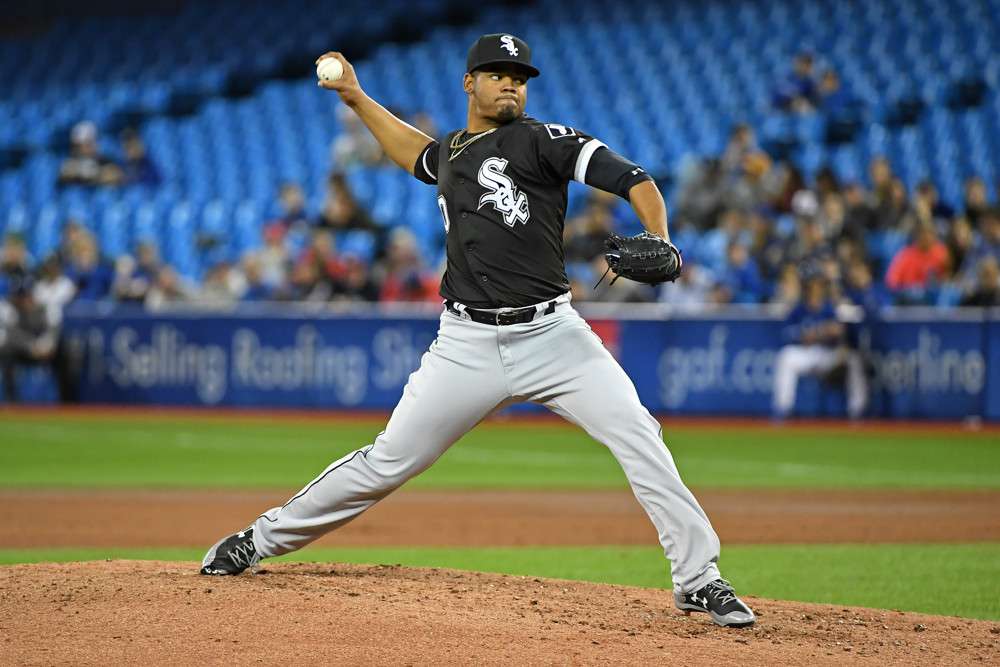
The 2018 season is less than two weeks old, and we’re approaching the point where we have a large enough sample size to feel comfortable analyzing meaningful statistics. Most analysis to this point, and even for the next week or two, will be subject to small sample size caveats and is not predictive of future success unless you choose to act on it as a hunch. The first metric to reach its “stabilization” point is strikeout rate for both pitchers and hitters. Some of the other key metrics are detailed below per work from both the FanGraphs and Baseball Prospectus team (link here). As a point of context, your 2018 league leader in plate appearances is Marcus Semien with 48, and the pitcher with the most batters faced is Carlos Martinez with 56.
“Stabilization” Points for Offense Statistics:
- 60 PA: Strikeout rate
- 120 PA: Walk rate
- 240 PA: HBP rate
- 290 PA: Single rate
- 1610 PA: XBH rate
- 170 PA: HR rate
- 910 AB: AVG
- 460 PA: OBP
- 320 AB: SLG
- 160 AB: ISO
- 80 BIP: GB rate
- 80 BIP: FB rate
- 600 BIP: LD rate
- 50 FBs: HR per FB
- 820 BIP: BABIP
“Stabilization” Points for Pitching Statistics:
- 70 BF: Strikeout rate
- 170 BF: Walk rate
- 640 BF: HBP rate
- 670 BF: Single rate
- 1450 BF: XBH rate
- 1320 BF: HR rate
- 630 BF: AVG
- 540 BF: OBP
- 550 AB: SLG
- 630 AB: ISO
- 70 BIP: GB rate
- 70 BIP: FB rate
- 650 BIP: LD rate
- 400 FB: HR per FB
- 2000 BIP: BABIP
All of this “stabilization” data isn’t to say that what comes next is meaningless. If we waited until we had a significant sample size on every waiver wire pick-up, we would miss out on every breakout player. The cost of adding a player on a hunch to see if early returns are a sign of a real breakout is so small, and the return so large, that it is imperative to look at these small sample sizes and act quickly on them. The exact cost is league-specific, where shorter benches mean you are more conservative before dropping a player you drafted for the end of your bench, but as your risk tolerance dictates, knowing how close a player is to a metric’s stabilization point can give you more ease about dropping your sleepers who just aren’t waking up.
Velocity Movers
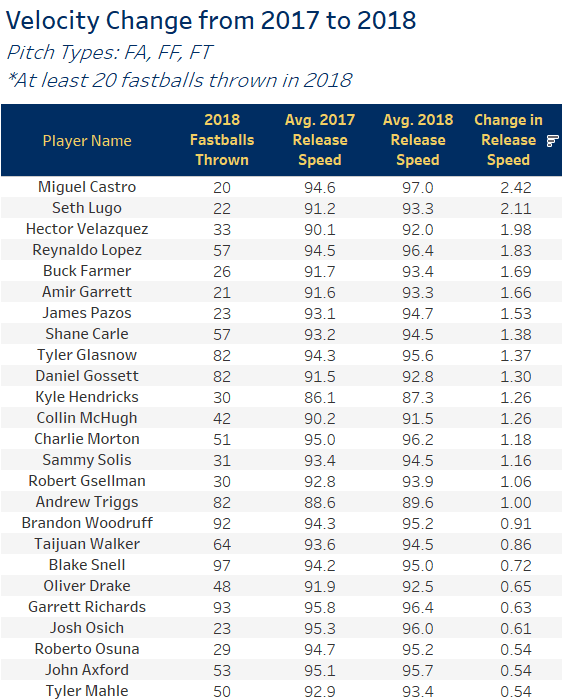
Observations
- Reynaldo Lopez is emerging as one of the best breakout fantasy players in 2018. After holding the Blue Jays to one earned run in six innings with six strikeouts to open the season, Lopez followed it up with another solid start at home against the Tigers. Neither offense is considered elite, but the strikeout-per-inning stuff including his 96.4 mph fastball will still play against better teams. His ownership is at 80%, so your chance to buy him is long gone, but he’s an interesting target in dynasty formats.
- A few really interesting holds options and speculative closers make this list as well. In order of preference, here are some players from the list I like as ratio boosters and who could find themselves in a closer spot down the road:
- Miguel Castro
- Seth Lugo
- Amir Garrett
- Shane Carle
- Tyler Glasnow is a really interesting arm to watch. A highly touted prospect, Glasnow is looking great while working in a bullpen role for the Pirates. Steven Brault looks to be an obvious candidate for Glasnow to replace, but as the only lefty in the rotation, it will take a string of struggling performances before Glasnow gets a shot. It’s also interesting to speculate if Glasnow goes the other direction and works his way up the bullpen depth chart. While Rivero has a firm grasp on the closer role, his fastball is down about two mph early in the season, and he’s showing some control issues. I get a little leery when a reliever who didn’t break in as a starting pitcher in the majors has a career year like Rivero did in 2017.
- A few starters on this list faced early struggles in their first start or two. I’m not panicking about any of them, especially with their velocities being up this early in the season. The rest of the stuff will come around, and I expect to see good seasons out of Kyle Hendricks, Taijuan Walker, Blake Snell, and Garrett Richards.
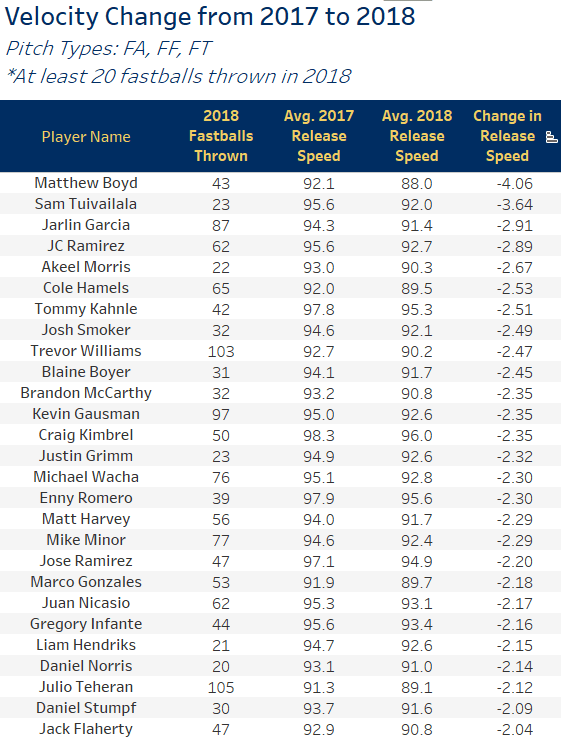
Observations
There are a limited number of things to comment on here because we’re still so early and starters have only one or two turns through the rotation. I wouldn’t act on any negative sign you see here, but do pay attention to these players and their next few times out because a prolonged stretch of decreased velocity could be a sign of injury. It is also worth nothing that I removed cutters off of this list. It was giving some misleading results for pitchers who throw two varieties of fastballs. Players appeared to be on this list due to declined velocity, but really it was just a change in pitch mix and leaning more or less heavily on the cutter.
Launch Angle Shifts
I’m altering the approach here this week. Instead of looking at increases/decreases of launch angle, I decided to look at which hitters are squaring the ball up at a higher rate. Using baseballsavant.com’s launch angle historical data, I decided to use the 7 degrees to 26 degrees as the “optimal” range. This includes all angles with which the expected batting average is above .500. The table below gives a full breakdown of expected outcomes by launch angle.
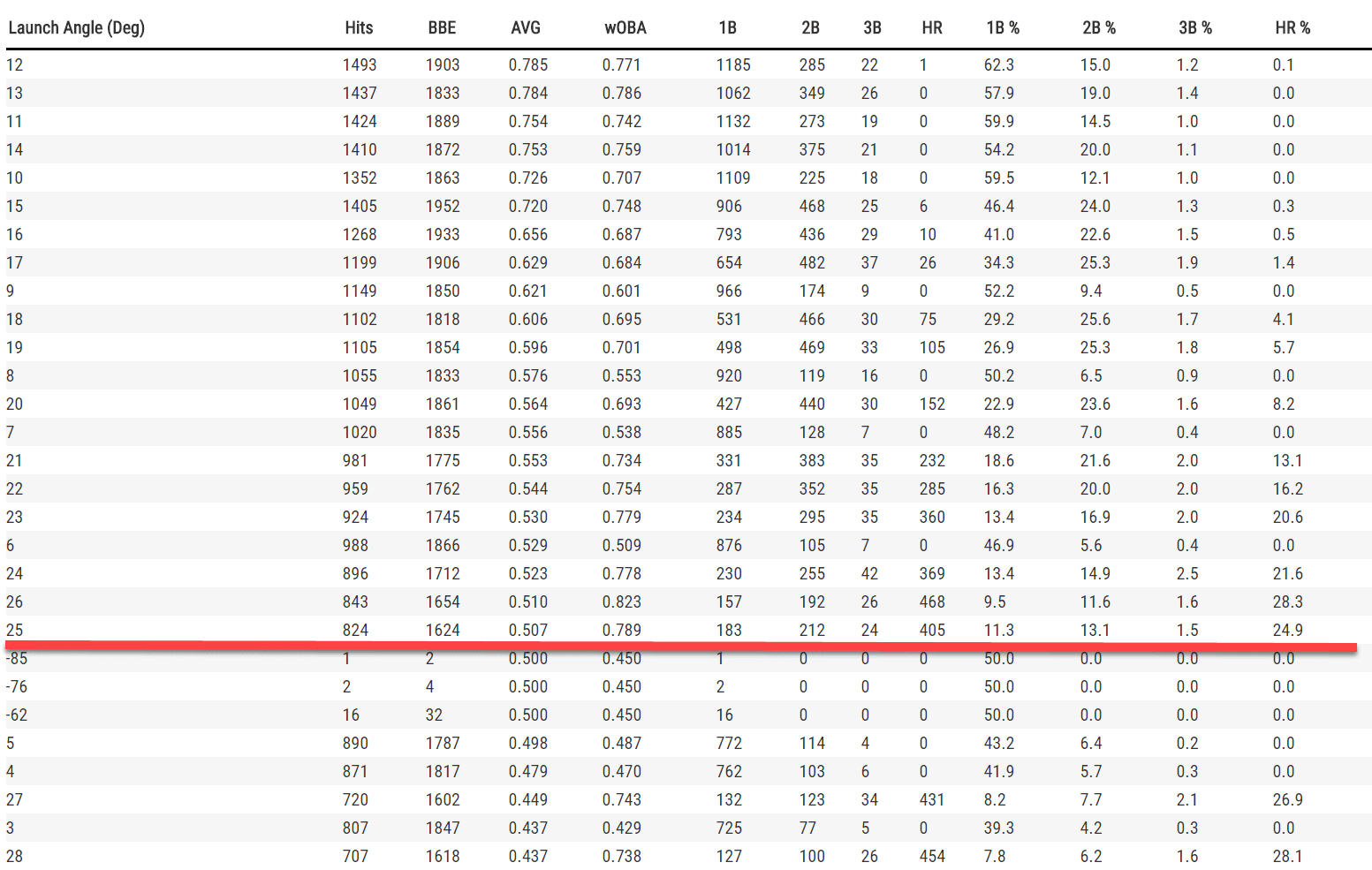
Using this 7 degree to 26 degree range, the table below shows which players are hitting in this range more frequently than 2017:

Observations
- Adam Eaton is a stud. We were all upset to see Trea Turner hitting sixth for the Nationals, but it’s for good reason — Adam Eaton is mashing right now.
- Nomar Mazara is figuring it out. The standard 5×5 fantasy numbers don’t quiet back it up yet, but Mazara is going to be a star. Now is the time to buy in. Every at-bat I’ve watched has been impressive, and he’s making quality contact seemingly every time up at the plate. All arrows are point up on Mazara’s dynasty stock.
- It’s not the hottest take, but count me out on Nick Ahmed’s hot start. He’s making good contact, but it’s with a worse exit velocity than he had last year, and his peripherals aren’t all that encouraging. In deeper formats where Ahmed’s good start might be relevant, try to flip him for anything else.
- I highlighted him two weeks ago in this article, but Addison Russell is one of the best buy lows at the shortstop position. Some off-the-field issues and injuries hampered him in 2017, but Russell is starting to deliver on that top-10 prospect pedigree the Cubs traded Jeff Samardzjia for.
Exit Velocity Improvements
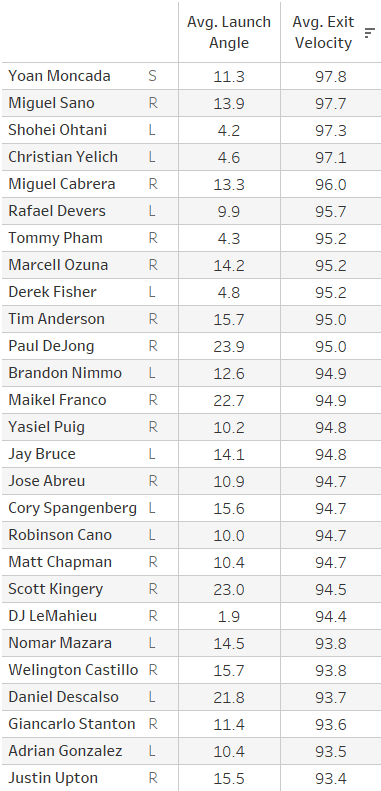
Observations
- Everyone on Twitter has done a sufficient job covering it, but holy crap is Shohei Ohtani a star. He’s mashing everything, and once he moves up from the eighth spot in the lineup, his production is going to skyrocket.
- Miguel Cabrera is clearly healthy and making those who took him in the eighth round look prophetic. He’s played in a lot of cold weather games, which is negatively impacting the output, but he’s making quality contact and should return to All-Star status if he can stay healthy.
- Yoan Moncada, Tim Anderson, and Jose Abreu are going to be a part of something special on the South Side of Chicago. All three are raking right now and giving the White Sox a ton to look forward to.
- Cory Spangenberg is a sneaky waiver wire target. His playing time isn’t 100% clear in San Diego, but he’s crushing the ball and should force his way into the lineup soon.
That’s all for now. I hope this data points you in the right direction on your early-season hunches. Again, this will evolve and continue to become more valuable as we get a larger sample size for 2018. If you have any questions or suggestions for improvement, please don’t hesitate to reach out on Twitter (@BrianCreagh) or via email ([email protected]).

Can we get a look at what these stats looked like last year after the first two weeks?